NAMM 2017 Saxophone Gear Roundup
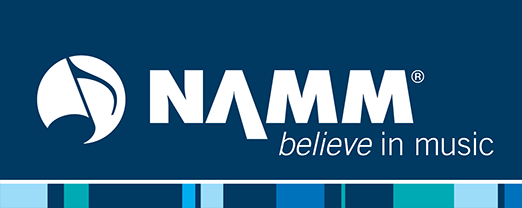
Introduction
This marks my 6th year attending NAMM (National Association of Music Merchants) and the show keeps getting bigger and better every year. Similar to the 2016 NAMM Show (2016 NAMM Show Saxophone Gear Roundup), the 2017 NAMM show was yet another year filled with more exhibitors showcasing new and updated products including: saxophones, necks, ligatures, mouthpieces, reeds, neck-straps and the list goes on. With only four days to see it all, I tried my best to test play as many products as I possibly could but unfortunately as always, I was not able to meet with every exhibitor that I wanted to see. Overall, I saw more tweaks or enhancements to current products than brand new models being showcased. I will be reviewing and revisiting some products I had a chance to try at the 2016 NAMM show as well as discussing some new products that have recently been launched for 2017. In addition to the reviewed products, I will list products at the show that I hope to test play at a later date as well as recommend you check out.
These products, in no particular order….
Ishimori Wood Stone “New Vintage” Alto Saxophone
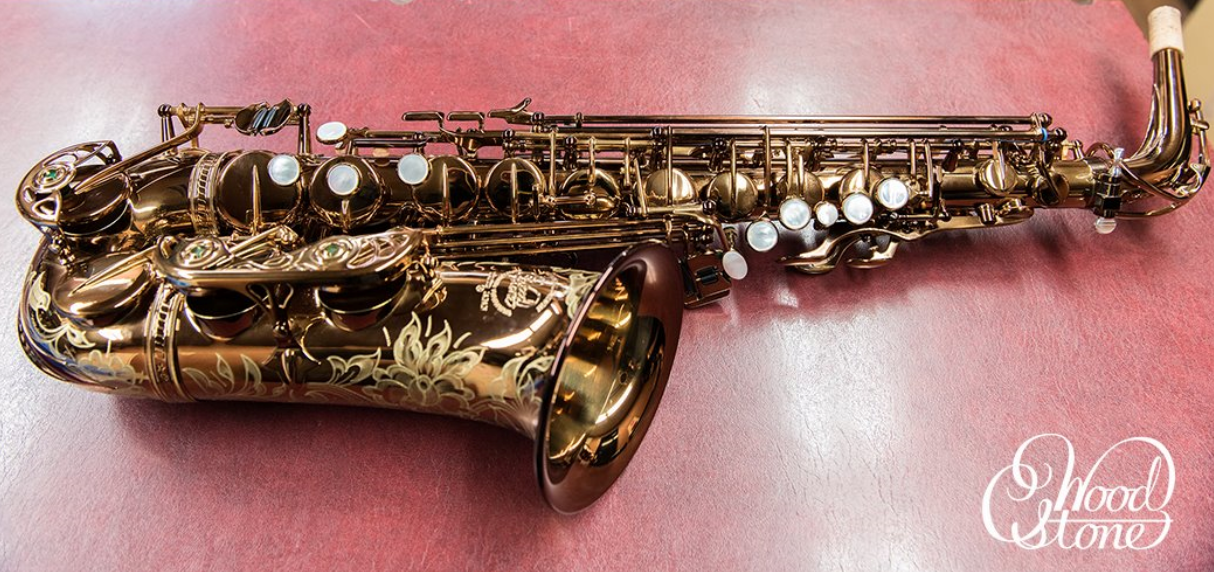
I was excited this year to test play the brand new Ishimori Wood Stone “New Vintage” alto saxophone. Since the Ishimori Wood Stone tenors played great at last year’s show, I was excited to see how the alto’s would turn out. I tested played all three finishes which were a gold lacquer, cognac lacquer, and antique finish. The antique finish was the only model without the high F# key and my favorite Ishimori alto at the show. Like the Ishimori Wood Stone tenors, the alto’s played extremely well. The ergonomics were incredibly comfortable and the action was light. Overall, I liked the antique finish sonically because I thought this saxophone had the right amount of resistance, warmth, edge, and projection. This saxophone played very well in tune with an even scale from top to bottom. I find with many modern alto’s, the palm keys voicing is what can differentiate a pretty good professional saxophone and a great professional saxophone and Ishimori really spent some time on his Wood Stone altos because all 3 finishes at the booth played exceptionally well. Some features unique to the Ishimori Wood Stone alto’s are as follows: Wood Stone Neck, Wood Stone lyre screw set, right and left Wood Stone thumb hook, two point mounting brace, nickel silver neck socket and reinforced rods just to name a few. I hope to test play the Ishimori Wood Stone alto’s in the very near future and wanted to thank the Ishimori team for being so helpful at their booth.
http://newvintagesax.com/index.html [Sorry(!), but this web page has disappeared since the original publication of this article]
Nadir Carbon Fiber MBII and SKY Mouthpiece & Harry Hartmann’s Fiberreed
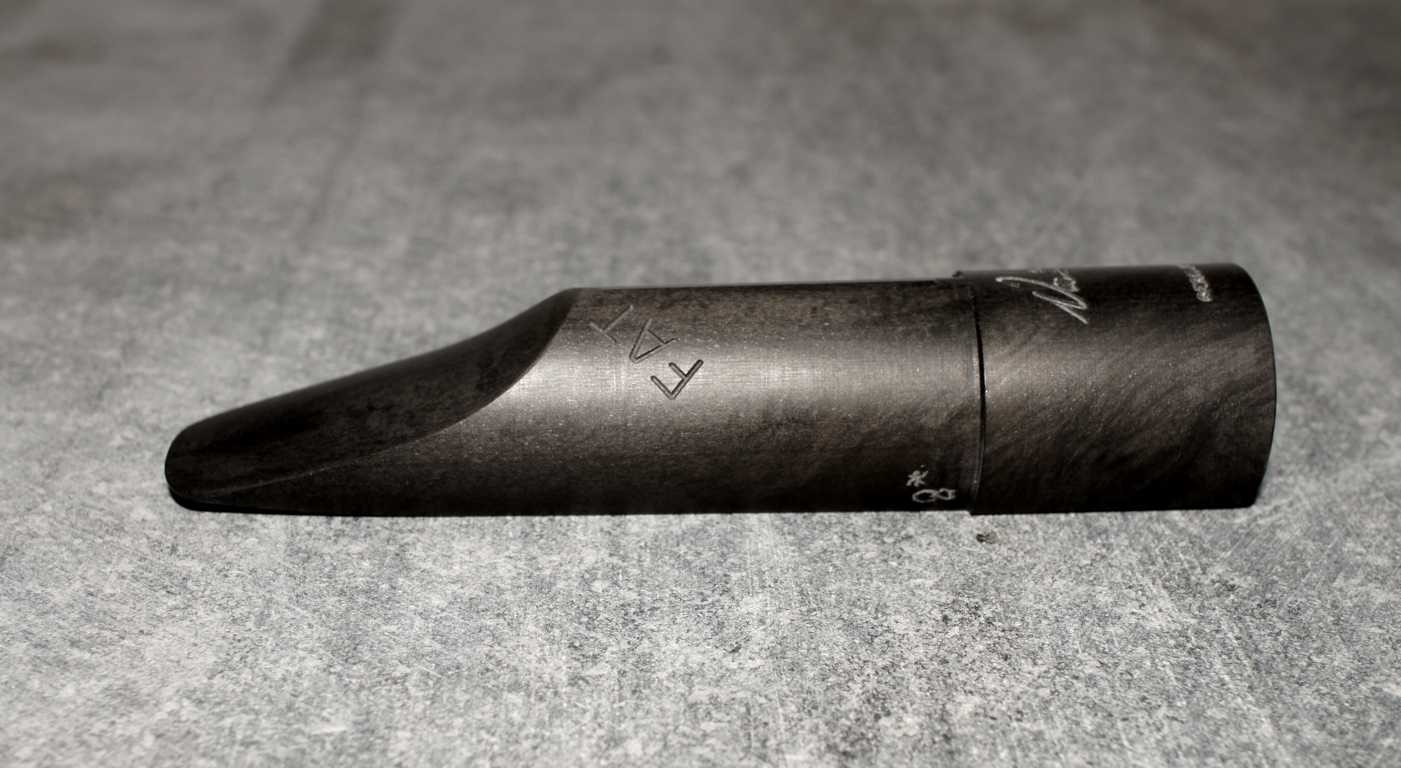
Since checking out Nadir’s mouthpieces and Harry Hartmann’s Fiberreed at the 2015 NAMM show (2015 NAMM Show: Part 2), I decided to stop by the booth and see if there were any new or updated products for 2017. The two new products I test played from Nadir were the new carbon fiber Sky and MBII model tenor mouthpieces as well as Harry Hartmann’s new Carbon Onyx Fiberreed. I have seen more manufacturers utilizing this carbon fiber material and was interested to see how it compared to metal. Nadir informed me his carbon fiber material is a mixture of carbon and fiberglass with these mouthpieces being the first non-metal Guardala mouthpiece ever made. Both the SKY and MBII were extremely light mouthpieces and as you can see from the picture, had a booster at the end of the mouthpiece which Nadir says helps balance and stabilize the sound. I test played a 7* Sky and 7* MBII. Compared to the traditional MBII and SKY in metal, this mouthpiece in carbon fiber played extremely well and had many of the same characteristics and feel of a metal mouthpiece. The sound was focused, warm, and both mouthpieces could be pushed without the sound backing off across all registers. Nadir told me that by using carbon fiber and today’s CNC machines he is now able to offer the MBII, SKY, and Studio Model at a lower price point than his traditional metal mouthpieces. Although at the end of the day I still preferred my slant link, I can see why so many players like Nadir’s line of mouthpieces.
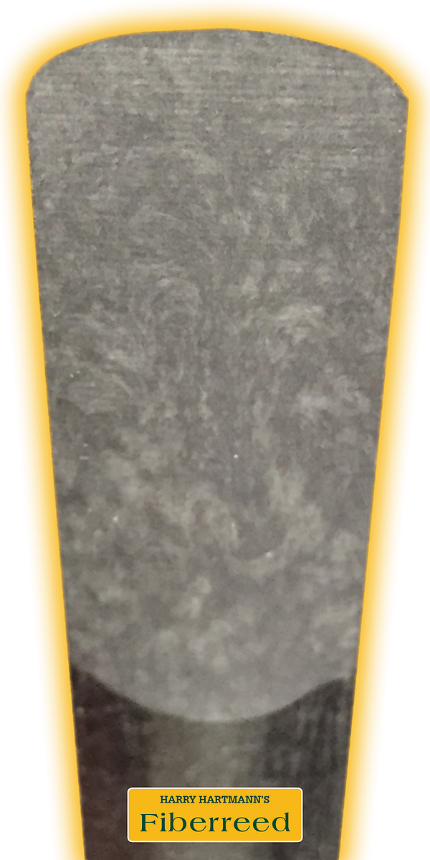
While test playing both the SKY and MBII, I used a traditional cane reed as well as tried Harry Hartmann’s new Carbon Onyx Fiberreed. After play testing both mouthpieces with each reed, I still prefer the sound and feel of traditional cane. This carbon onyx reed sounded very similar to cane and even the feel was close but there were some subtle differences which is why I still prefer traditional cane (at the moment). I would have to say the carbon onyx Fiberreed is my favorite synthetic reed’s that Harry Hartmann’s is offering at this time.
http://nadirsaxwind.com/fibercarbon/
LC Saxophones

(This is not the model I test played at NAMM but is part of the T-600 series)
I have heard and know of the LC saxophone line from Taiwan but have never had the chance to sit down and actually test play one. After visiting a few booths and running into Woody Witt (great saxophonist and educator from Houston Texas), he told me to check out some of the saxophones at the LC Saxophone booth. When I visited the booth, I test played the various tenor saxophone models which ranged from the T-601-T604. The model I and many players seem to prefer was the “vintage” finish which I believe was the T-603 model made up of 95% red copper. This high copper content I have not seen in the past and traditionally many saxophones that do utilize copper are around 85% copper. This saxophone had blue steel springs, Italian leather pads, metal resonators, black mother of pearl key touches, a high F# key and no engraving. I overall liked the sound of this saxophone but would request that the action be lighter. The overall tuning from top to bottom was pretty good and I was able to try a sterling silver neck with this model which I did enjoy as well. The overall setup and construction felt good with all pads sealing and tone holes level but I would have some adjustments made by my repairman in terms of action and key heights. I am looking forward to trying out the LC saxophones at the next NAMM show and spending a bit more time with these various models.
Marmaduke “Feather” Strap III
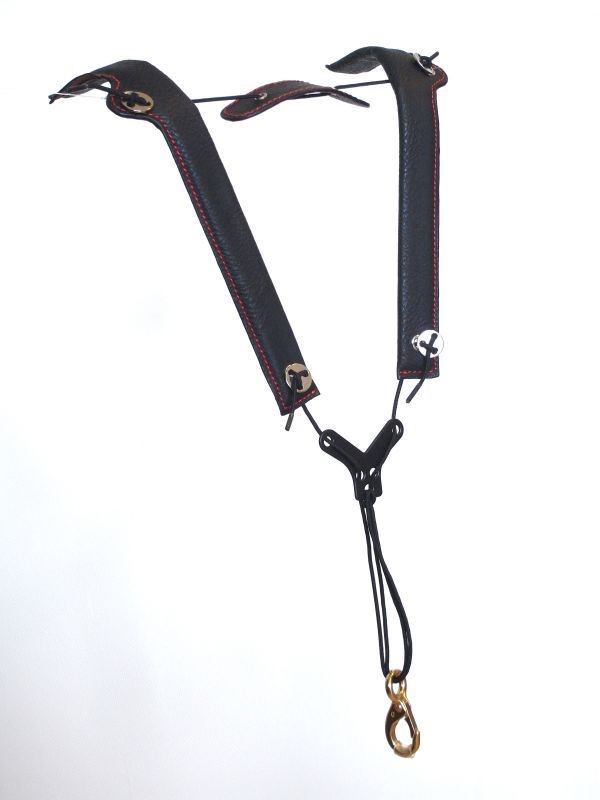
While visiting Marmaduke Mouthpieces and Straps, Alex Miyatake, owner of Marmaduke Music, introduced me to his Marmaduke “Feather Strap” III. This strap was designed to alleviate pressure from your neck and distribute the weight equally across your shoulders. I typically use a saxholder neck-strap but tried the Marmaduke “Feather” Strap III strap to see how it compared to the “Feather” Strap II. The newly designed slider on the 3rd version made it easier to adjust the height and in addition, the new brass hook attached to the saxophone strap ring more securely and gave me similar mobility that I experience when using my saxholder neck-strap. This Marmaduke “Feather” Strap III comes in one size for soprano, alto, tenor, and baritone saxophone. Overall, I think Alex made some nice enhancements to this neck-strap and I am looking forward to using the new Marmaduke “Feather” Strap III on alto and tenor saxophone.
Marmaduke “Feather” Strap III Product Info
Trevor James Signature Custom Series “Vintage” Tenor Saxophone
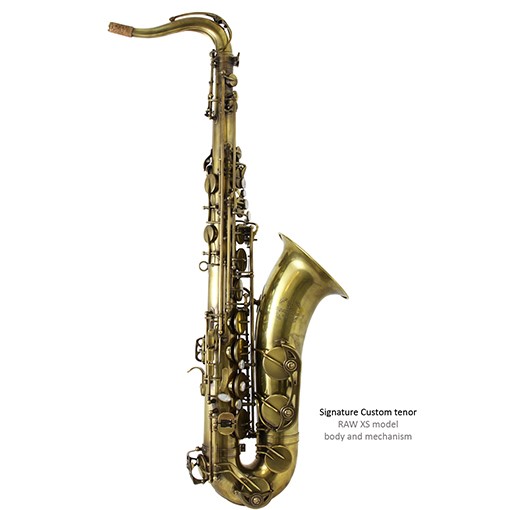
I have been checking out the Trevor James Signature Custom Series saxophones for over the past four years and this line by Trevor James gets better and better every single year. When I stopped by the booth this year, I test played the RAW XS, RAW, Silver, and Gold Lacquer finishes. One of the RAW XS tenor models, I would call their “vintage” prototype in terms of the ergonomics and keys were laid out just like a 5 digit Mark VI (without high F#) which is different from the traditional signature custom series saxophones. In addition, this model is going to be setup with a different neck which will most likely please those players looking for a bit more weight or back-pressure to push against resulting in some additional complexities and character to the overall sound. I really enjoyed this tenor when it came to the ergonomics, key layout, and overall response and consistency from top to bottom. This Raw XS “vintage” prototype and the Trevor James signature custom line of saxophones were incredibly consistent from horn to horn which is not always the case while test playing various manufacturers saxophones. I want to thank Sandro, Tom, and David for allowing me to spend some time to test playing each horn and especially David for spending a great deal of time setting each horn up because they all really played great. I am looking forward to re-visiting the Trevor James booth at next year’s NAMM show and am looking forward to further play testing the RAW XS “vintage” prototype this year.
Trevor James Signature Custom Series Tenor Comparison
CE Winds Pure Vintage OL Slant Signature Tenor Saxophone Mouthpiece & Pure Vintage NY Meyer Alto saxophone mouthpiece
When I stopped at the CE Winds booth this year, I had the opportunity to test play the CE Winds Pure Vintage Otto Link Slant Signature tenor mouthpiece and Pure Vintage NY Meyer Alto saxophone mouthpiece.
Pure Vintage OL Slant Signature Tenor Mouthpiece
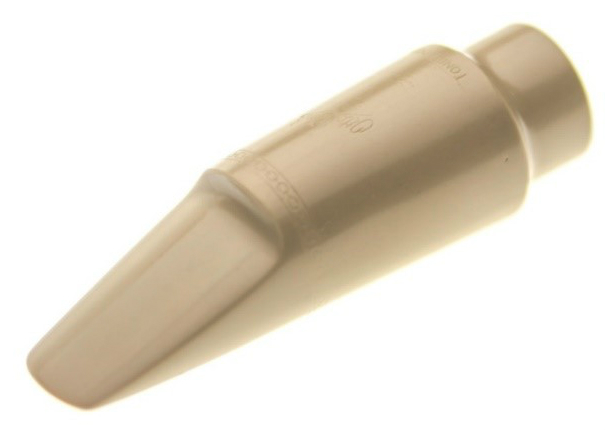
I play on an original Otto Link Slant Signature tenor mouthpiece with a 7 tip opening. Brian Seltz, President of CE Winds, had 2 Pure Vintage OL Slant Signature tenor mouthpieces in 7* tip openings. I tried both mouthpieces and overall was impressed by the response, projection and play-ability. This mouthpiece felt very similar to my current slant link and embodied many of the same characteristics (edge, warm, dynamic range, etc). I will say the CE Winds Pure Vintage mouthpiece played a little bit brighter than my current slant as well as was a bit more free-blowing than my current slant. Overall, this is my favorite hard rubber mouthpiece CE Winds has to offer especially for those players looking for a Slant Link copy at a very affordable price of $199. I know this mouthpiece is not made out of hard rubber but a resin or composite that I would agree feels and responds very similar to hard rubber but would prefer hard rubber. Brian told me the Pure Vintage OL Slant Signature Tenor Saxophone Mouthpiece was designed from an original “Big” USA 7* Slant Signature made by Otto Link in Pompano Beach, Florida – tip measures out to approximately .107″.
http://www.youtube.com/watch?v=mZDxMdb8PxY
Pure Vintage NY M 6M Alto Mouthpiece
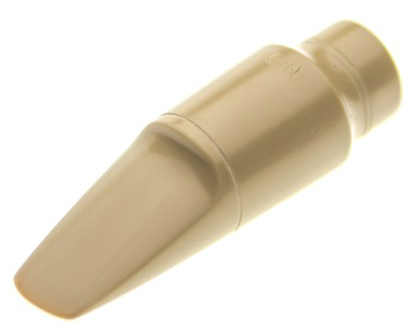
The vintage New York Meyer mouthpieces are some of the best hard rubber mouthpieces I have played to date but as many of us know, they are quite hard to find and if you do find one, these mouthpieces are demanding much higher prices than many other modern and vintage mouthpieces on the market today. I found the CE Winds Pure Vintage NY Meyer 6M to play very similar to an original New York Meyer mouthpiece I have played in the past. The CE Winds Pure Vintage NY Meyer was warm, great articulation, tuned well, even scale throughout, and had a very similar response and buzz that many of us who have played vintage Meyers are looking for in a mouthpiece. Like the Pure vintage OL Slant tenor mouthpiece, the CE Winds Pure Vintage NY Meyer is made up of the same material and I would also note that this mouthpiece played a tad brighter than N.Y Meyers’s I have played in the past which could be to do the material but it is hard to say. Brian informed me that the Pure Vintage N Y M 6M Alto Saxophone Mouthpiece was designed from an original Meyer New York USA, Medium Chamber 6M Alto Saxophone Mouthpiece with a tip measuring out to a .076. Like the CE Winds OL Slant tenor mouthpiece, overall, this is my favorite alto hard rubber mouthpiece CE Winds has to offer especially for those players looking for a New York Meyer copy at a very affordable price of $179. I want to thank Brian for allowing me to try both these mouthpieces and hope to play both these mouthpieces in the near future.
http://www.youtube.com/watch?v=7LbkaS9ASho
D’Addario Select Jazz Tenor Mouthpiece
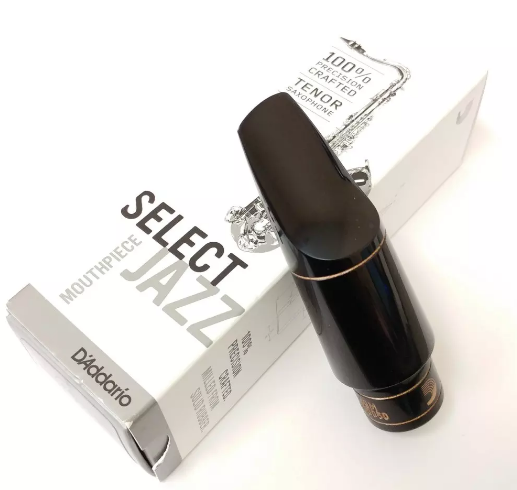
Since The D’Addario Select Jazz alto mouthpiece came on the market as D’Addario’s efforts to offer a professional vintage meyer-like copy at a very affordable price, D’Addario will soon be releasing their D’Addario Select Jazz Tenor Mouthpiece. I was able to meet up with Kristen Mckeon, Product Specialist at D’Addario, and she was nice enough to let me try a D’Addario Select Jazz Tenor Mouthpiece with a 7 tip opening. I found out that this mouthpiece was based on one of Jeff Coffin’s Freddie Gregory mouthpieces that he has played for quite some time. When I test played the D’Addario Select Jazz tenor mouthpiece to compare to my Slant Link I was pleasantly surprised. I found the D’Addario Select Jazz tenor mouthpiece responded well with the sound leaning a bit towards the brighter side compared to my slant but for a mouthpiece that is completely CNC’d, there was warmth, edge, and character to the sound. This mouthpiece articulated very well and personally, I think this new tenor mouthpiece will be more popular than the existing D’Addario Select Jazz alto mouthpiece. With that being said, the D’Addario Select Jazz tenor mouthpiece will be released in March and I wanted to thank Kristen for allowing me to play test the new D’Addario Select Jazz Tenor mouthpiece.
Link: D’Addario Select Jazz Tenor Mouthpiece
ReedGeek Klangbogen (New Finishes)
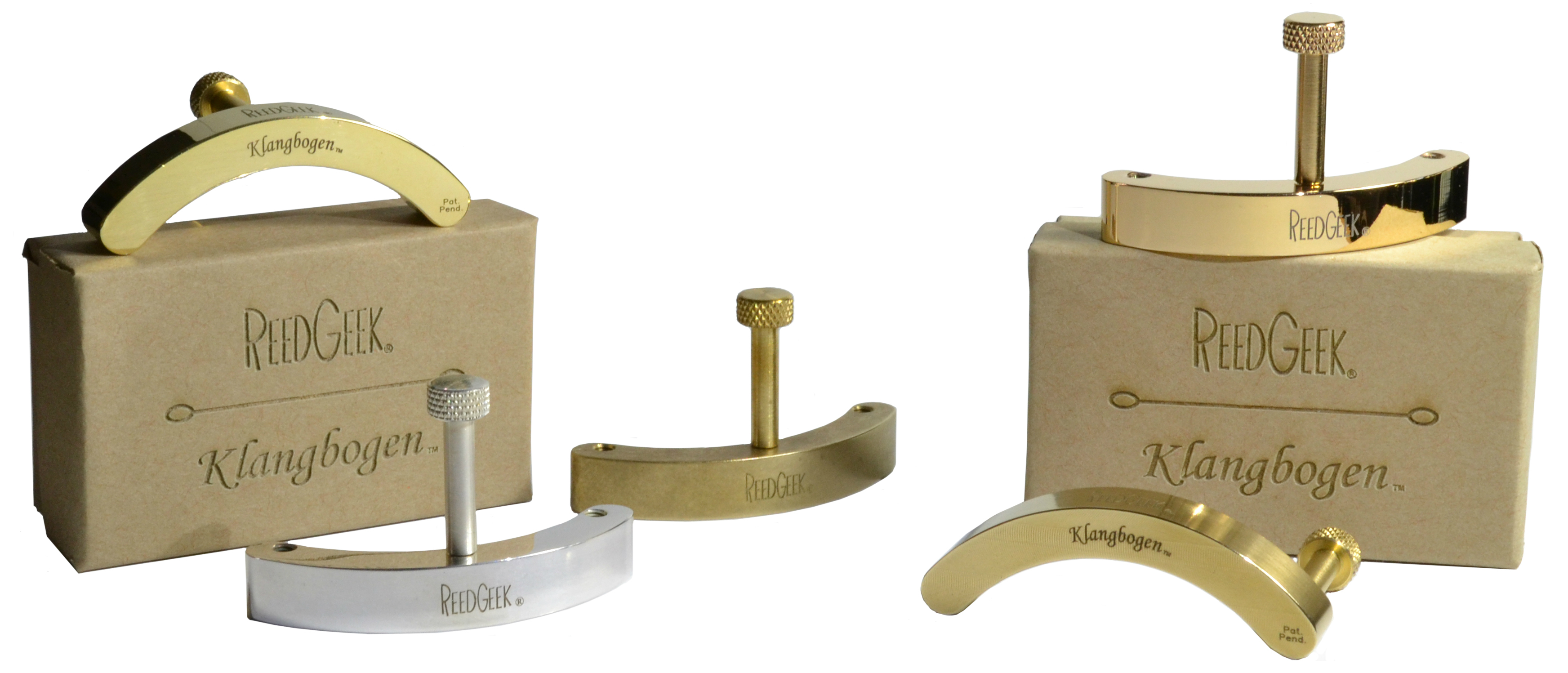
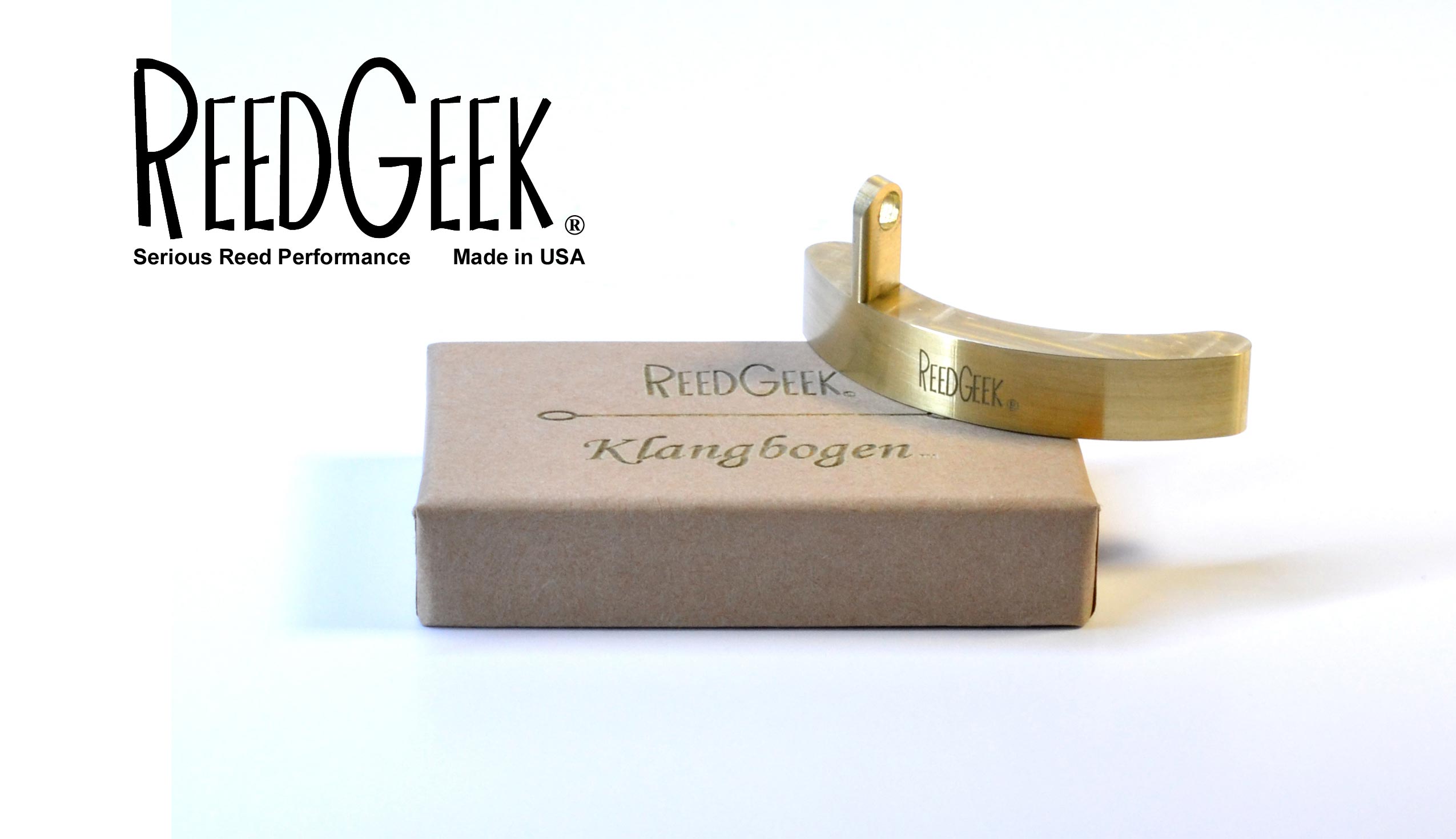
After testing playing the Klangbogen at the 2016 NAMM show (2016 NAMM Show Saxophone Gear Roundup), I visited the ReedGeek booth again and Mauro (Owner of ReedGeek) introduced me to the various new finishes that he has just released. Mauro told me found surprisingly that each finish had some impact on how the saxophone responded and it’s completely personal taste which Klangbogen finish various players have chosen. Mauro did inform me that those players who play on Yamaha’s and Yanagisawa’s currently, will be excited to know a Klangbogen model that fits both these brands and others will be released very shortly. I currently use the standard brass finish Klangbogen but here are the new finishes that just came out and there overall sonic characteristics according to Mauro:
- High-Polished Brass: “ Add’s great focus and guts to the sound”
- Marbled Brass: “Promotes the darkest core and “woofy” like core”
- Brushed Matte Brass: “The most bell-like high’s”
- Sterling Silver-Plate: “Promotes the clarity of the sound in the high frequencies”
- 24KT Gold Plate: “The richest and most velvety sound”
I recommend trying out each finish of the Klangbogen to see which one works for you and fits your particular saxophone. I did hear a difference between each and overall do feel that using the Klangbogen offers a more fluid and consistent response throughout all registers of my saxophone. I want to thank Mauro for taking the time to sit down and show me each different finish.
http://www.reedgeek.com/klangbogen/
Sax Dakota 42 and 52 alto and tenor saxophone
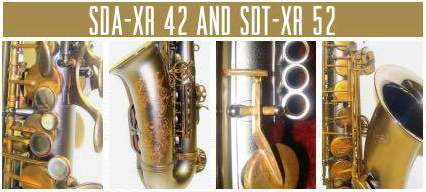
When I stopped by the Sax Dakota booth this year, Pete LaPlaca, (Owner of SaxDakota) and David Hayes(artist relations manager) introduced me to their new SDA-XR 42 (alto) and SDT-XR 52 (tenor) saxophones. I had reviewed the SDT XR 92 a few months back (Sax Dakota SDT-XR-92 Review) and wanted to see how the new XR 42 and XR 52 compared. The tenor model utilizes a 6.26” graduated bell size and the alto a 5.32” alto bell size. The triple neck strap ring, double key arms and low profile key cups/pads are just a few features of the new features on the XR 42 and XR 52 models. The body/bow/and bell are plated in a semi matte dark onyx finish over a bronze alloy that it utilized in the XR 82 and XR 92 models. The necks were finished with a silver plating and hand engraved. I found the XR 42 and 52 to responded similarly to the XR 82 and 92 models but found that both new models were a bit more free-blowing which I think can be attributed to the new neck taper. I found the overall intonation and action was good but would have the spring tension lightened. My recommendation would be if you enjoy playing on the XR 82 or XR 92 model, you should check out the XR 42 and 52 models.
http://www.saxdakota.com/products.html
Silverstein Estro Ligature and OmniCap

The Silverstein ligatures have grown in popularity over the years so I decided to stop by the booth this year to see what new products they had in store for 2017. Timothy Zerone and Sean Yang told me about the new Silverstein Estro ligature, Omnicap, and upcoming news on the Silverstein saxophone reeds coming out later this year. I compared the Silverstein Cryo 4 which I have played for some time on tenor against the new Estro ligature. Some of the new features on the Estro ligature are as follows: the harmonic enhancers or metal bars now contact the mouthpiece, zircon gemstones were added for appearance, and a thinner thread was utilized to allow the reed to vibrate even more just to name a few. I found subtle differences between both ligatures but found while test playing each one, the new Estro ligature vibrated a bit more than the Cryo 4 and found the sound to project more in the upper and lower register while the Cryo 4 I found pushed the sound a bit towards the darker spectrum. In addition to the Estro ligature, Silverstein introduced the Omnicap which is a new mouthpiece cap designed to be light-weight, fit all mouthpieces, and preserve reed moisture. I want to thank Sean and Tim for discussing Silverstein’s new products for 2017 and can’t wait to check out the Silverstein saxophone reeds once they come out in stock.
http://www.silversteinworks.com/
Forestone RX Saxophone
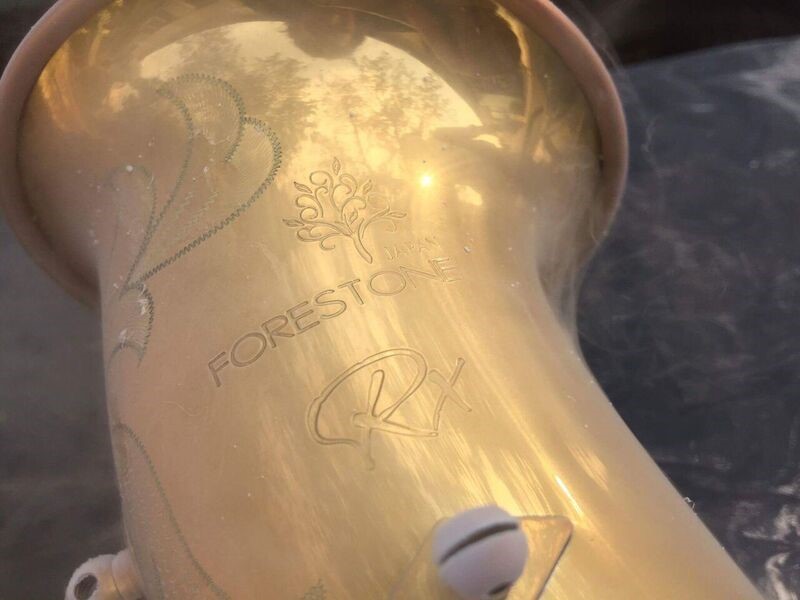
When I visited the Forestone booth this year, Lar’s Heusler (CEO of Forestone) introduced me to the rolled tone hole model saxophone offered by Forestone called the RX model. The RX model has rolled tone holes that are soldered on and this saxophone goes thru Forestone’s “W Cryo treated” process which means they cryogenic freeze all parts of the saxophone twice as the effect is even more noticeable for allowing the brass to naturally resonate. The setup on this model is very much close to the straight tone hole model in terms of action and key layout. I prefer the straight tone hole model but for those of you that have played rolled tone hole model saxophones currently will very much like this option from Forestone. I want to thank Lars for adding this new model to the Forestone line of saxophones.
Ergonomic Sax Stand
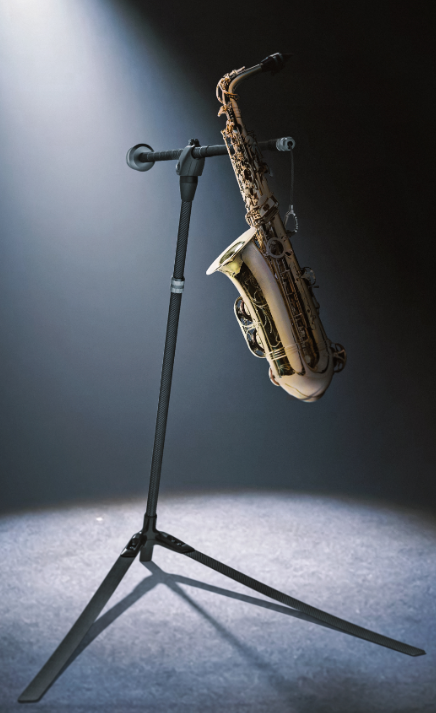
Besides testing out various saxophones, neckstraps, reeds, ligatures, mouthpieces, necks, etc. I am always interested in finding out if there are any new and one of a kind products on the market that could potentially help saxophonists. One product I had never seen before was the Ergonomic Sax Stand. I met John Mackey, Fiona Nelms, and Stephen Holgate from The Australian National University. John Mackey told me that as a saxophone player he was suffering from a bad spine and neck pain and with engineer Stephen Holgate’s help, the Ergonomic Sax Stand was born. This saxophone stand can accommodate alto, tenor and baritone saxophone and is height adjustable. The stand was designed to take up to 100% of the weight off the player’s neck although this can be adjusted for individual preference. What’s important is this stand allows a full range of movement while being used and would mostly likely fit well in recording studios and teaching environments. I was a bit hesitant at first regarding the Ergonomic Sax Stand but after trying this stand and adjusting, I noticed the Ergonomic Sax Stand can remove all the pressure from your neck. The new Ergonomic Sax Stand coming out later this year will be made out of carbon fiber for portability and resilience. I know many of us use various neckstraps and harnesses to distribute the weight from our neck to our shoulders evenly but for those of you that have severe back problems or are realizing more neck, shoulder, and back pain from playing, should seriously consider checking out the Ergonomic Sax Stand see if it is the right fit for you. Whether you use it during performances or to simply practice, the stand works.
http://www.youtube.com/watch?v=6gc1e61ft0I&feature=youtu.be
Honorable mentions
- Rampone & Cazzani (King Super 20 style tenor saxophone) (http://www.rovnerproducts.com)
- Oleg Products (http://olegproducts.com/)
- Cannonball “Black Ruby” Finish (http://www.cannonballmusic.com/)
- Joel Harrison ligature (http://www.sax-works.com/)
- Ochres Saxophones (http://www.ochresmusic.com/)
Conclusion
The 2017 NAMM Show was filled with new artists, products, and most importantly new exhibitors showcasing their saxophones, ligatures, mouthpieces, reeds, necks, neck straps, sax stands and the list goes on. What I have seen over the past 5+ years, besides the introduction of new products, is improvements in the manufacturing and assembly of saxophones and accessories. These improvements I believe have led to the manufacturing of better quality saxophones/accessories at a more affordable price point allowing more players access to better quality equipment. Unfortunately, I was not able to visit every booth at the show that I wanted to and spend the amount of time I would have liked to test play various products. As always, to any of the manufacturers I met at NAMM, if I did not include you in this list, this is not a reflection on your product, it just came down to time. If you would like me to review your product specifically or have any questions, please feel free to contact me using the information from my author bio below. Again, another great NAMM Show and I can’t wait to see what NAMM 2018 has in store for us saxophonists next year!






February 22, 2021 @ 1:27 pm
I have been trying to find more information on the ASU Ergonomic Sax Stand, and cannot find any contact info. This is exactly the stand I need, would appreciate your assistance in locating more info.
Thank you!!
March 8, 2021 @ 12:11 am
Hey Lance,
I would reach out to: https://physics.anu.edu.au/contact/people/profile.php?ID=367.
Stephen Holgate (info via link) since he built the stand.
Another one you can check out is
Sax Stand: https://saxseat.com/?v=9025a1ae8c64